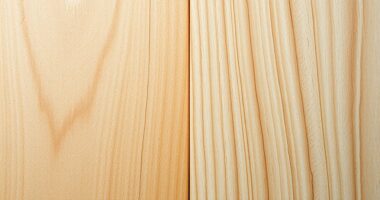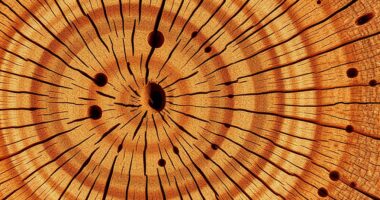To identify wood density and hardness, you measure how much a sample weighs relative to its volume, typically using water submersion or geometric calculations for density, and a Janka test or similar methods for hardness. These measurements reveal the wood’s strength, durability, and suitability for various projects. By understanding these properties, you can select the right wood for your needs. Keep exploring to uncover more about these essential identification methods.
Key Takeaways
- Measure wood density by weighing a sample and calculating volume via water displacement or geometric formulas.
- Use the Janka hardness test to determine resistance to denting and penetration with a steel ball.
- Calculate density in g/cm³ or lb/ft³ to compare toughness and durability of different woods.
- Conduct laboratory hardness tests like Brinell or Vickers for precise measurement of wood hardness.
- Relate density and hardness data to assess suitability for specific applications like flooring or carving.

Understanding wood density and hardness is essential if you want to choose the right type of wood for your projects. These two qualities influence how a wood performs, its durability, and how easy it is to work with. To effectively identify and compare different woods, you’ll need to understand the methods used for density measurement and hardness testing. These techniques give you reliable data, helping you make informed decisions.
Density measurement involves determining the amount of mass a piece of wood contains relative to its volume. Typically, you start by weighing a sample of the wood and then measuring its volume, often by submerging it in water or using geometric calculations. The resulting value, usually expressed in grams per cubic centimeter (g/cm³) or pounds per cubic foot (lb/ft³), reveals how dense the wood is. Higher density generally indicates a tougher, more durable material, which is important for projects requiring strength or resistance to wear. Conversely, lower-density woods tend to be lighter and easier to carve, making them suitable for decorative or lightweight applications.
Hardness testing methods are designed to assess how resistant a wood is to denting, scratching, or penetration. One common approach is the Janka hardness test, which measures the force needed to embed a steel ball into the wood to half its diameter. This test provides a numeric value that reflects the wood’s ability to withstand impact and load. The higher the Janka number, the harder the wood. Other hardness testing methods include the Brinell and Vickers tests, which are more precise but less commonly used outside laboratory settings. When choosing a wood for a specific purpose, understanding these hardness testing methods helps you gauge how well the material can handle daily wear and tear.
Frequently Asked Questions
How Does Moisture Content Affect Wood Density Measurements?
Moisture content considerably impacts your wood density measurements because moisture variability causes density fluctuation. When the wood is moist, it appears denser, but as it dries, the density decreases. To guarantee accurate readings, you should control or account for moisture levels, typically by oven-drying samples. This way, you minimize the effects of moisture variability, providing consistent and reliable density measurements for proper identification.
Can Wood Hardness Be Accurately Tested on Small or Irregular Samples?
You can absolutely test wood hardness on small or irregular samples, but don’t expect perfect accuracy. Tiny or oddly shaped samples make measurement accuracy a real challenge—it’s like trying to weigh a feather with a freight scale. Using the right tools and techniques helps, but be prepared for some variability. For the most reliable results, bigger, more uniform samples are your best bet, especially if precision matters.
What Are the Limitations of Traditional Density Testing Methods?
Traditional density testing methods face limitations primarily due to sample size and measurement accuracy. Small or irregular samples can yield inconsistent results, making it hard to get reliable data. These methods often require precise measurements, but irregular shapes and sizes can introduce errors. As a result, you might struggle to accurately determine wood density, especially when working with limited or uneven samples, affecting your identification and analysis.
How Do Environmental Factors Influence Wood Hardness Over Time?
Did you know environmental impact and growth conditions can change wood hardness by up to 15% over a tree’s life? You’ll find that fluctuating moisture, temperature, and soil nutrients influence cell structure, making wood softer or harder over time. These factors affect durability and suitability for specific uses, so understanding how growth conditions impact hardness helps you select the right wood for your project and anticipate how it might evolve.
Are There Non-Destructive Techniques for Assessing Wood Density?
You can use non-destructive testing methods, like imaging techniques, to assess wood density without damaging the sample. Techniques such as X-ray imaging, ultrasonic testing, or near-infrared spectroscopy allow you to analyze internal structures and density variations accurately. These methods are quick, reliable, and preserve the wood, making them ideal for quality control, conservation, or research purposes without compromising the integrity of the material.
Conclusion
By understanding wood density and hardness, you access a world of precise identification—more reliable than a detective’s intuition. These methods are your ultimate tools, transforming what might seem like simple measurements into powerful indicators of quality and origin. Mastering them guarantees you won’t be fooled by imposters or inferior woods, making your expertise unparalleled. In this domain, your knowledge becomes a force as mighty as a storm, shaping every decision with clarity and confidence.









